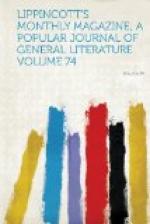Being anxious to see a good display of Turkish rugs, and our party having some commissions to execute, we sallied forth one afternoon on this errand. If you intend to visit a Turkish carpet warehouse, and your purse or your judgment counsels you not to purchase, put yourself under bonds to that effect before you go; for, unless you possess remarkable strength of character, the beautiful rugs displayed will prove irresistible temptations. Near the bazaar in Stamboul is a massive square stone house, looking like a fortress compared with the buildings around it. Mosses and weeds crop out of every uneven part of its walls. A heavy door that might stand a siege admitted us to a small vestibule, and from this we passed into a paved court with a moss-grown fountain in the centre. Around this court ran a gallery, its heavy arches and columns supporting a second, to which we ascended by a broad flight of steps. A double door admitted us to the wareroom, where, tolerably secure from fire (the doors alone were of wood), were stored Turkish and Persian rugs of all sizes and colors. The Turkish were far handsomer than the Persian, and the colors more brilliant than those I have usually seen. The attendants unrolled one that they said was a hundred years old. It had a dusty, faded look, as if it had been in the warehouse quite that length of time, and made the modern ones seem brighter by contrast. Several rugs having been selected, we returned to the office, where a carpet was spread and we were invited to seat ourselves on it. Coffee was passed around, and we proceeded to bargain for our goods through our interpreter. The merchant, as usual, asked an exorbitant price to start with, and we offered what was equally ridiculous the other way; and so we gradually approached the final price—he coming gracefully down, and we as affably ascending in the scale, till a happy medium was reached, and we departed with our purchases following us on the back of an ammale.
[Illustration: THE SULTAN ABDUL ASSIZ.]
Three days of each week are observed as holy days. Friday is the Turkish Sabbath, Saturday the Jewish, and the Greeks and Armenians keep Sunday. The indolent government officials, glad of an excuse to be idle, keep all three—that is, they refrain from business—so there are only four days out of the seven in which anything is accomplished.




